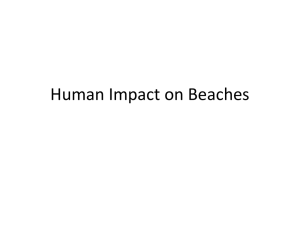- Beach prisms
advertisement
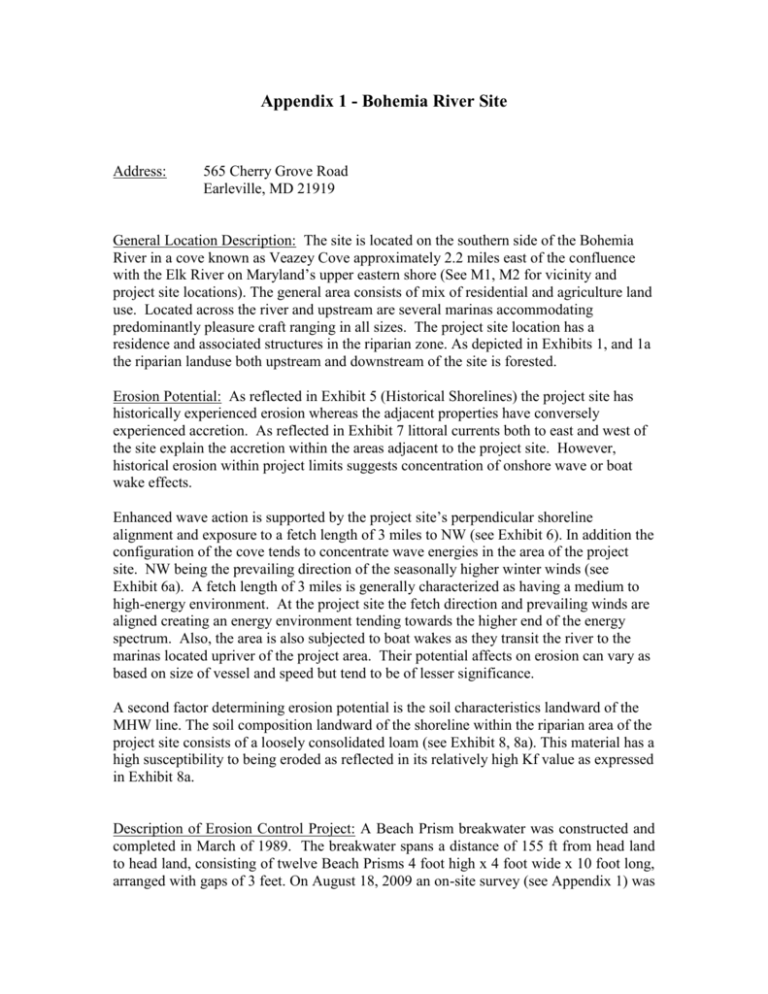
Appendix 1 - Bohemia River Site Address: 565 Cherry Grove Road Earleville, MD 21919 General Location Description: The site is located on the southern side of the Bohemia River in a cove known as Veazey Cove approximately 2.2 miles east of the confluence with the Elk River on Maryland’s upper eastern shore (See M1, M2 for vicinity and project site locations). The general area consists of mix of residential and agriculture land use. Located across the river and upstream are several marinas accommodating predominantly pleasure craft ranging in all sizes. The project site location has a residence and associated structures in the riparian zone. As depicted in Exhibits 1, and 1a the riparian landuse both upstream and downstream of the site is forested. Erosion Potential: As reflected in Exhibit 5 (Historical Shorelines) the project site has historically experienced erosion whereas the adjacent properties have conversely experienced accretion. As reflected in Exhibit 7 littoral currents both to east and west of the site explain the accretion within the areas adjacent to the project site. However, historical erosion within project limits suggests concentration of onshore wave or boat wake effects. Enhanced wave action is supported by the project site’s perpendicular shoreline alignment and exposure to a fetch length of 3 miles to NW (see Exhibit 6). In addition the configuration of the cove tends to concentrate wave energies in the area of the project site. NW being the prevailing direction of the seasonally higher winter winds (see Exhibit 6a). A fetch length of 3 miles is generally characterized as having a medium to high-energy environment. At the project site the fetch direction and prevailing winds are aligned creating an energy environment tending towards the higher end of the energy spectrum. Also, the area is also subjected to boat wakes as they transit the river to the marinas located upriver of the project area. Their potential affects on erosion can vary as based on size of vessel and speed but tend to be of lesser significance. A second factor determining erosion potential is the soil characteristics landward of the MHW line. The soil composition landward of the shoreline within the riparian area of the project site consists of a loosely consolidated loam (see Exhibit 8, 8a). This material has a high susceptibility to being eroded as reflected in its relatively high Kf value as expressed in Exhibit 8a. Description of Erosion Control Project: A Beach Prism breakwater was constructed and completed in March of 1989. The breakwater spans a distance of 155 ft from head land to head land, consisting of twelve Beach Prisms 4 foot high x 4 foot wide x 10 foot long, arranged with gaps of 3 feet. On August 18, 2009 an on-site survey (see Appendix 1) was conducted to supplement and validate archival information sources (see Appendix 2) The alignment of the structure is east to west. At the time of the survey a maximum distance of 32.8 feet was measured at the mid-point along the structure to the shoreline and the top 1.65 feet of the Beach Prism was exposed. Pictures 1 through 5 depict the structure from east to west. Exhibit 3 and 3a depict shoreline structures in the vicinity and reflects the Beach Prism breakwater. In addition as evidenced and inter-dispersed throughout the toe of the bank is stone approximately 60 to 80 lbs in weight (see Picture 7) Over the last 20 years the Beach Prisms have maintained both alignment and elevation. The latter as reflected in the top 1.5ft being exposed above MHW as based on rectified field measurements taken at the time on the on-site survey. A soil profile taken at the base of the beach prism was homogenous to depth of 12 inches and consisted of a sandy clay as based upon sand, silt, clay partitioning. Based upon these factors the Beach Prism is in accordance with the manufactures recommended installation guidelines for design depth and foundation requirements. Assessment: Performance of the Beach Prisms is based on the bank and buffer conditions behind the structure and adjacent properties both upstream and downstream of the structure. The bank and buffer conditions as observed (see Picture 3) and as reflected on Exhibits 2 and 2a indicate a stabilized, totally vegetated bank and buffer landward of the beach prisms. Additionally, landward of the Beach Prisms and predominately at the east / west ends and interspersed throughout is emergent and submerged aquatic vegetation (see Picture 7 and Exhibit 4). The latter as provided by accumulation of sand and subsequent beach creation. As based on observation and as reflected in Exhibit 2a adjacent upstream and downstream properties are stable and totally vegetated. This suggests sand as accumulated behind the structure is derived from the re-distribution of off shore versus along shore sand sources. This also supported by the site defining its own reach wherein sediment processes are independent of upstream and downstream conditions. As based upon these observations and archival information, the Beach Prisms as used in the context of this site have demonstrated an ability to provide an effective barrier against erosion and environment for wetland creation. APPENDIX 1 Onsite Survey 1) Date and Conditions The site was surveyed on August 18, 2009 at approximately 11:40am. There was a slight water chop. Winds were light out the NW. Skies were mostly sunny. High tide occurred at 8:35am. 2) Project Description The beach prisms span a distance of 155 ft from head land to head land, consisting of twelve Beach Prisms 4 foot high x 4 foot wide x 10 foot long, arranged with gaps of 3 feet. The alignment of the structure is east to west. At the time of the survey a maximum distance of 32.8 feet was measured at the mid-point along the structure to the shoreline and the top 1.65 feet of the Beach Prism was exposed. Pictures 1 through 5 depict the structure from east to west. 3) Site Description a) Residence and associated structures are adjacent to the near shore zone. b) Vegetated bank in the near shore area ranged in height between 5 to 10. Evidenced at the toe of the bank and interspersed with vegetation is stone approximately 60 to 80lbs in weight. (See Picture 7) c) Channelward of the bank and landward of the Beach Prism and predominately at the east / west ends and interspersed throughout is emergent vegetation. (See Picture 6) d) Throughout the area and channelward of the Beach Prism for distances in excess of 100ft is dense coverage of submerged aquatic vegetation. e) Depths ranged from 2ft at the Beach Prism to 4 ft at a distance of 300 ft channelward of the Beach Prism. f) A soil profile taken at the base of the Beach Prism was homogenous to depth of 12 inches and consisted of sandy clay. APPENDIX 2 Archival Information 1) Riparian Land Use a) At Site: Residential b) Upstream: Forested c) Downstream: Forested 2) Bank and Buffer Conditions a) At Site: i) 5 – 10 ft bank / low erosion, total bank coverage ii) marsh / low erosion b) Upstream: i) 5 – 10 ft bank / low erosion, total bank coverage ii) marsh / low erosion iii) Phragmites australis c) Downstream: i) 5 – 10 ft bank / low erosion, total bank coverage ii) marsh / low erosion 3) Shoreline Features a) At Site: Breakwater / riprap b) Upstream: NA c) Downstream: NA 4) Submerged Aquatic Vegetation a) At Site: 70 to 100% coverage b) Upstream: 70 to 100% coverage c) Downstream: 70 to 100% coverage 5) Historical Shorelines a) At Site: erosion b) Upstream: accretion Exhibits 1, 1a 2, 2a 3, 3a 4 5 c) Downstream: accretion 6) Bathymetry / Fetch /Wind 7) Littoral Drift 8) Soils 6, 6a 7 8, 8a

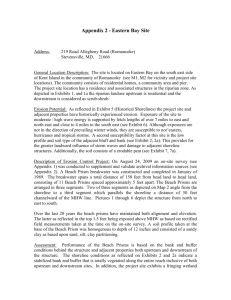

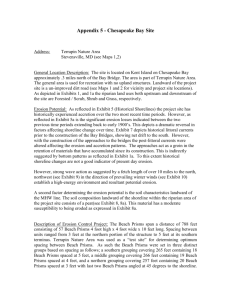


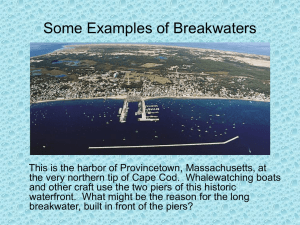
![PERSONAL COMPUTERS CMPE 3 [Class # 20524]](http://s2.studylib.net/store/data/005319327_1-bc28b45eaf5c481cf19c91f412881c12-300x300.png)
